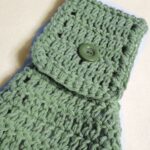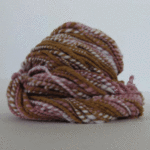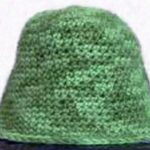I learned to knit when I was seven years old. I learned how to make knit stitches from friends at school. My mother’s friend taught me to cast on with a simple method. I had a ball of yarn from a crochet project that I used with a pair of pencils as knitting needles. When my mother noticed what I was doing, she bought me my first pair of true knitting needles- a 14″ long, bright red pair of size 15 needles.
I made pillows, bedspreads, curtains and more with those needles. Over time, I learned to read patterns. I purchased a book and other needles with babysitting money; I was off and running. I made my own money in the 70s; other kids were begging Mommy and Daddy for loose change. I wasn’t rich, but I had something in my pocket besides lint.
Today, I love to teach knitting to anyone willing to learn. I was riding the bus today and heard a man declare that knitting was a “dead art.” I couldn’t stop laughing- it’s far from dead. It’s making a comeback. Store-bought goods lack in grace and quality. They’re not known for lasting long at all. And the fit leaves a lot to be desired.
When you knit, you can customize the entire garment from start to finish. Any color, size or type of yarn, knitting stitches or patterns are at your disposal.
Change the size of yarn and needles to change the gauge. The gauge is simple to explain. How many stitches on the needle equal one inch? How many knitted rows equal one inch? That’s the gauge. How tight or loose you knit will also affect the gauge.
Practice any pattern until you get the gauge.
This poncho can be used as a poncho, a throw, a pillow or a winter wrap. Once you make one, choose your favorite knitting patterns to insert into your next poncho or embroider the stitches. You can switch out yarn colors to create other patterns as well.
You will need:
- · Yarn
- · Knitting needles- circular needles are useful for the number of stitches used at the center.
- · Scissors
- ·:
Hold your arms out to your side. Have someone measure from your wrist to wrist, or where you want your poncho to fall. Some like a poncho to fall at the wrist, some only want a poncho to fall (or end) at the elbow. It’s your poncho- decide where you want it to be.
Measure from your shoulder to where you want your poncho to fall in front.
Record these measurements on a piece of paper.
Knit a practice swatch of garter stitch. This is knitting on each row. Measure your piece to obtain your gauge. Record this gauge- it’s going to come in handy.
Step Two:
Make a slip stitch on the needle. It should be loose.
Knit two stitches in the one loop. Achieve this by knitting into the front and the back of the loop without taking the loop off the first needle.
Knit the next second row. There will be two stitches.
On the next row, knit two stitches into the first stitch. Do the same in the next stitch. You now have four stitches. This will be called pattern row one.
Knit the next row. This will be called pattern row two.
On the next row: Repeat pattern row one. You will now have six stitches.
On the next row: Repeat pattern row two.
Repeat pattern rows one and two until you have reached the number of stitches required to reach across your arms.
For example, if you need 500 stitches, stop when you reach this number. Do not cast off.
Step Three:
Count your stitches and mark the center. Measure around your head and add two inches. Divide this number by half. Divide by half again. Using your gauge, count the number of stitches needed on each side of the center to achieve the desired width. Mark the stitches on either side.
It is easiest if you are on a pattern row two for this step.
Knit to the first marker. Begin casting off the stitches between the markers. You may need to cut the yarn and leave a long tail. You can work this in later. When you reach the end of the markers, join the yarn again and knit to the end.
Step Four:
Knit to the stitch where the casting off took place; do not take the last stitch off your needle. Insert your needle into the stitch and pull a loop through. Place this on the needle next to the last stitch. Insert your needle into this loop and do this again. Keep doing it until the loops equal the number of cast off stitches. This is called cable-cast on.
Knit four rows.
Step Five:
Now we begin to decrease on the other side of your poncho.
Pattern row one: Knit two stitches together, knit to the last two stitches, knit them together.
Pattern row two: Knit all the way across.
Continue pattern row one and two until you have one two stitches left. Knit them together on a pattern one row.
Finish off and weave in all ends of your yarns.
Step Six:
The poncho is ready to wear. You can embellish it with different ideas:
- · Add tassels all around the edges.
- · Crochet lace or other edging around the outer edges.
- · Crochet around the neck opening.
- · As you become comfortable with knitting, use a stockinette stitch or any series of stitches to create a pattern or picture in your poncho.
- · Use different necklines in your poncho.
- · Create a simple hood for your poncho.
- · With practice, you can make pockets and attach them to the front, or learn how to knit pockets into your project. Make fake pocket flaps for a decoration.
- · For a springier, or stretchier, softer poncho, knit into the back of the stitches. This is not a purl stitch. Place your needle into the back of the stitch and make a knit stitch. It also makes a warmer poncho.
- · You can use any size of yarn, or use two or three yarns at once with a large needle. Your imagination is the only limitation you have.
- · Use regular-sized yarn with large needles for a lacy look. This looks cool with the above technique.
Ponchos make wonderful Christmas gifts. They are simple, easy to make and fun to give and use.
Source: The author of this article has over 40 years of experience in diverse forms of DIY, home improvement and repair, crafting, designing, and building furniture, outdoor projects, RV’ing and more.





